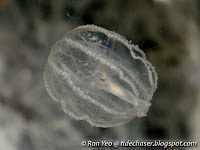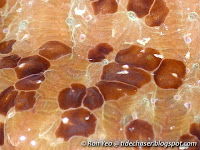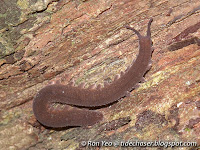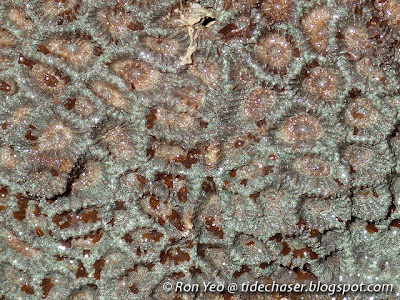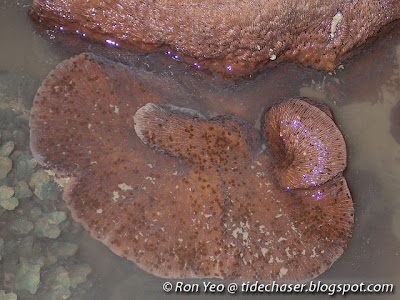Animals (kingdom Animalia) are multicellular organisms that get the energy they need by consuming food. They are eukaryotes, i.e living things with cells containing a nucleus and other structures enclosed within membranes. They, however, lack rigid cell walls. All animals are able to move at least some part of their body, and many are able to move from place to place.
The various species of animals can be scientifically classified into smaller groups (called phyla) based on their physical appearances and, more recently, their DNA as well. A wide variety of animals from various phyla have been recorded from Singapore, and the members of the same phyla usually share a few physical or behavioural adaptations.
Here are some of the distinguishing features that will be useful in helping to make an educated guess of the phylum of an unfamiliar animal encountered in Singapore.
1. Sponges (Phylum Porifera)

Field characteristics:
2. Comb Jellies (Phylum Ctenophora)

Field characteristics:
3. Cnidarians (Phylum Cnidaria)

Field characteristics:
4. Horseshoe Worm (Phylum Phoronida)

Field characteristics:
5. Moss Animals (Phylum Bryozoa)

Field characteristics:
6. Lamp Shells (Phylum Brachiopoda)

Field characteristics:
7. Acoel Worms (Phylum Acoelomorpha)

Field characteristics:
8. Echinoderms (Phylum Echinodermata)
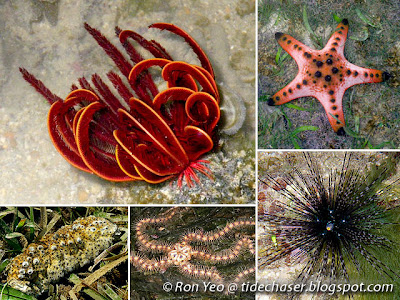
Field characteristics:
9. Hemichordates (Phylum Hemichordata)

Field characteristics:
10. Annelid Worms (Phylum Annelida)

Field characteristics:
11. Ribbon Worms (Phylum Nemertea)

Field characteristics:
12. Flatworms (Phylum Platyhelminthes)

Field characteristics:
13. Velvet Worms (Phylum Onychophora)

Field characteristics:
14. Arthropods (Phylum Arthropoda)

Field characteristics:
15. Molluscs (Phylum Mollusca)
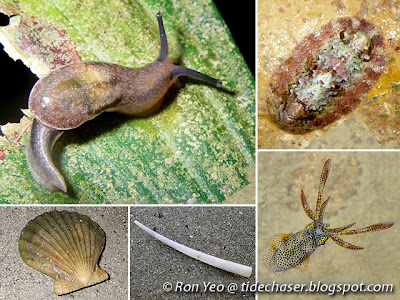
Field characteristics:
16. Chordates (Phylum Chordata)

Field characteristics:
References
The various species of animals can be scientifically classified into smaller groups (called phyla) based on their physical appearances and, more recently, their DNA as well. A wide variety of animals from various phyla have been recorded from Singapore, and the members of the same phyla usually share a few physical or behavioural adaptations.
Here are some of the distinguishing features that will be useful in helping to make an educated guess of the phylum of an unfamiliar animal encountered in Singapore.
1. Sponges (Phylum Porifera)

Field characteristics:
- Usually have many small pores and one or more bigger openings.
- Cells display considerable degree of independence.
- Sessile and little detectable movement.
- The body has no obvious symmetry.
- Hard corals - Some of the colourful sponges are often mistaken to be hard corals. Hard corals, however, have hard, rock-like skeletons, while sponges have a spongy or rubbery feel when touch. Avoid touching sponges with your bare hands though (wear gloves!), as many species have sharp spicules.
- Soft corals - Some sponges with leaf-like or tree-like growth forms may be mistaken for soft corals. Sponges tend to be covered in tiny pores of varying sizes, but not soft corals.
- Bryozoans - Encrusting or lace-like bryozoans may be mistaken for sponges. A closer examination will reveal cell-like patterns in the bryozoans, which are the zooecia (or exoskeleton) of the individual zooids (the bryozoan animal).
- Tunicates - Colonial tunicates are often mistaken for sponges. To differentiate them from the latter, take a closer look to spot the individual zooids that will not be present in sponges.
- Seaweed - Some sponges harbour symbiotic algae in them and appear plant-like.
2. Comb Jellies (Phylum Ctenophora)

Field characteristics:
- Jellyfish-like (free-swimming ones) or flatworm-like (non-swimming ones).
- Many of free-swimming and non-swimming ones come with a pair of long tentacles fringed with smaller tentacles. See this photo from Wikimedia which features numerous flatworm-like ctenophores extending their long tentacles on a sea star.
- Most free-swimming species have eight strips (called comb rows) running down the length of their body. Each strip bears bands of hair-like projections (or cilia) which resemble a comb.
- Scyphozoan jellyfish - Scyphozoan jellyfish generally have numerous (instead of only two) tentacles, and lack the comb rows.
- Hydromedusae - Mature hydrozoans sometimes exist as a free-swimming medusa (jellyfish). They generally have numerous (instead of only two) tentacles, and lack the comb rows.
- Flatworms - Non-swimming ctenophores often somewhat resemble flatworms, but they possess the long tentacles fringed with smaller tentacles which the latter lack.
3. Cnidarians (Phylum Cnidaria)

Field characteristics:
- Radially symmetrical animals with tentacles.
- Possess explosive, harpoon-like cells (cnidocytes).
- May be solitary or colonial.
- Solitary animals can be sessile (flower-like polyp) or motile (medusa, commonly called jellyfish).
- Colonial animals build skeleton which does not display the radial symmetry, but individual animals in the colony still exhibit the radial symmetry.
- Sea anemones
- Tube anemones
- Corallimorphs
- Hard corals
- Zoanthids
- Soft corals
- Blue corals
- Sea pens
- Hydroids
- Jellyfish
- Sponges - Some sponges, depending on the growth form, may be mistaken for branching, boulder or encrusting hard corals and blue corals. Some may also be confused with soft corals. Sponges can be distinguished by the numerous tiny pores of varying sizes and the lack of a rock hard skeleton (to differentiate from hard corals).
- Comb Jellies - Scyphozoan jellyfish and hydromedusae may be confused with comb jellies, but the latter only have two tentacles (if present) fringed with smaller tentacles. Most comb jellies also have eight strips (called comb rows) running down the length of their body.
- Bryozoans - Encrusting or lace-like bryozoans may be mistaken for hard corals, while tree-like bryozoans may be mistaken for hydroids. A closer examination will usually reveal cell-like patterns in the bryozoans, which are the zooecia (or exoskeleton) of the individual zooids (the bryozoan animal). Some tree-like bryozoans, however, may lack the cell-like patterns, and instead, the zooids are lined tightly along the sides of the upper branches. Hydroids generally have polyps that are arranged by the sides of the branches at regular intervals.
- Fan worms - Fan worms are sometimes mistaken for sea anemones and tube anemones due to their flower-like appearances. The tentacles of fan worms, however, are feather-like (with a main "stalk" in the middle and fine hairs lining the sides.)
- Horseshoe worms - Horseshoe worms may also be mistaken for sea anemones, or a cluster of them may be mistaken for zoanthids or corallimorphs. Their crown of tentacles, however, are arranged in a somewhat horseshoe shape if viewed from the top, appearing like two separate spirals but are actually connected.
- Feather stars - Due to the feather-like arms and pentaradial symmetry, feather stars may be mistaken for sea anemones by some people. They, however, lack the body column, and have claw-like arms on the underside.
- Seaweed - Soft corals and hydroids may have plant-like appearances, but they lack the succulence of the latter. Also, the individual polyps will be radially symmetrical, and if they have retracted, there will be small bumps or holes on the surface of the colony housing them.
- Rocks - Hard corals may be confused with rocks. They have have regular depressions and patterns (forming the corallites) on the surface though.
4. Horseshoe Worm (Phylum Phoronida)

Field characteristics:
- Live in tubes and with a crown of tentacles arranged in a somewhat horseshoe shape when viewed from the top.
- The species recorded from Singapore lives commensally with various species of tube anemones from the family Cerianthidae by boring into the walls of their tubes.
- Fan worms - Fan worms are sometimes mistaken for horseshoe worms due to their flower-like appearances. The crown of tentacles of the horseshoe worm, however, is arranged in a somewhat horseshoe shape when viewed from the top, appearing like two separate spirals but are actually connected.
- Cnidarians - Due to the crown of tentacles, and their habit of congregating sometimes, horseshoe worms may be mistaken for sessile cnidarians, such as sea anemones, tube anemones, zoanthids or corallimorphs.The crown of tentacles of the horseshoe worm, however, is arranged in a somewhat horseshoe shape when viewed from the top, appearing like two separate spirals but are actually connected.
5. Moss Animals (Phylum Bryozoa)

Field characteristics:
- Form plant-like, lace-like or encrusting colonies.
- The individual bryozoan animal (or zooid) usually lives in a "chamber" (or zooecium), which is a protective chitinous or calcareous exoskeleton.
- A closer examination will usually reveal cell-like patterns in the bryozoans, which are the zooecia (or exoskeleton) of the individual zooids (the bryozoan animal). Some tree-like bryozoans (see diagram from bryozoa.net), however, may lack the cell-like patterns, and instead, the zooids are lined tightly along the sides of the upper branches.
- Cnidarians - Encrusting or lace-like bryozoans may be mistaken for hard corals, while plant-like bryozoans may be mistaken for hydroids. A closer examination will usually reveal cell-like patterns in the bryozoans, which are the zooecia (or exoskeleton) of the individual zooids (the bryozoan animal). Some plant-like bryozoans, however, may lack the cell-like patterns, and instead, the zooids are lined tightly along the sides of the upper branches. Hydroids generally have polyps that are arranged by the sides of the branches at regular intervals.
- Tunicates - Colonial tunicates are sometimes mistaken for bryozoans. To differentiate them from the latter, take a closer look to spot the individual zooids, which lack the cell-like patterns.
- Sponges - Encrusting or lace-like bryozoans may be mistaken to be sponges, but the latter lack the cell-like patterns found on the bryozoan colonies.
- Seaweed - Some bryozoans have plant-like appearances, but they lack the succulence of the latter. Also, a closer examination will usually reveal cell-like or segmented patterns in the bryozoans.
- Mollusc eggs - The egg ribbons and capsules of some molluscs may be confused with bryozoans, but they lack the cell-like patterns as well.
6. Lamp Shells (Phylum Brachiopoda)

Field characteristics:
- Appear clam-like with a two-part shell, comprising a dorsal (or "upper") valve and a ventral (or "lower") valve.
- The two valves are usually not symmetrical, but the line of symmetry is perpendicular to the hinge line.
- Many species, such as the one recorded from Singapore anchors itself in soft substrates with a stalk-like structure called a pedicle.
- Bivalves - Lamp shells have a two-part shell, and hence are often confused with bivalves. Bivalves, however, have a ligament that joins the valves near the hinge, which forces the two valves open when the adductor muscles relax. Lamp shells lack this ligament, and hence their shells often remain close even after the animal is dead. And for bivalves, if a line of symmetry is present, it is usually parallel to the hinge line, while for the lamp shells the line of symmetry is perpendicular to the hinge line.
7. Acoel Worms (Phylum Acoelomorpha)

Field characteristics:
- Appear flat, bilaterally symmetrical, soft-bodied and unsegmented.
- Do not have a gut cavity.
- Have a distinctive balance sensory receptor (made up of a large cell bearing a calcareous body), appearing like a round spot near the front end. This is usually hard to see without a hand lens though.
- The species recorded in Singapore are small (typically less than 0.5cm) and congregate on hard corals and corallimoprhs.
- Flatworms - Acoels appear like tiny flatworms, but they have a distinctive balance sensory receptor near the front end, appearing like a round dot when viewed under a hand lens. The species recorded in Singapore congregate on hard corals and corallimorphs.
8. Echinoderms (Phylum Echinodermata)

Field characteristics:
- Marine animals with penta-radial symmetry, i.e. each echinoderm can be divided into 5 equal parts, at least in some stage of life.
- Possess a water vascular system, which is a network of water-filled vessels within their body, terminating usually at numerous tiny tube feet on the undersides.
- Marine slugs - Some smaller sea cucumbers may be mistaken for marine slugs, but can be distinguished from the latter by having oral tentacles and tube feet.
- Sea anemones - Feather stars are occasionally mistaken for sea anemones due to their long arms. They, however, lack the body column, and have claw-like arms on the underside. Some sea cucumbers, especially the burrowing ones, may be mistaken for sea anemones too when they extend their oral tentacles to feed. They have an anus though, which sea anemones lack.
- Annelid worms - Some sea cucumbers may be mistaken for earthworms, peanut worms and other annelid worms due to their long and slim bodies, but can be distinguished by their oral tentacles and tube feet.
9. Hemichordates (Phylum Hemichordata)

Field characteristics:
- Appear worm-like animals with a three-part body - the front end, followed by a collar, and a posterior trunk.
- Swallow sand or mud and digest the tiny organic particles inside, and excrete the processed sediment in coils (called cast) during low tide. Usually, only the casts left behind during low tide are seen.
- The body is very fragile and breaks apart when dug out from its burrow.
- Annelid worms - Hemichordates seen on the shore may be mistaken for earthworms, peanut worms and other annelid worms due to their long and slim bodies. The cast resembles those made by lug worms. The only sure way to distinguish hemichordates is to check for the three-part body plan.
10. Annelid Worms (Phylum Annelida)

Field characteristics:
- Bilaterally symmetrical worms which may or may not be segmented.
- Segmented species have a body comprising identical segments (excluding the head and tail) containing the same set of organs, and in some cases, external structures used for locomotion.
- Unsegmented annelids are believed to have lost the segments through evolution, and include the spoon worms with a flattened proboscis resembling a spoon on their front ends, and the peanut worms with a body comprising an unsegmented trunk and a retractable structure called an "introvert".
- Hemichordates - Hemichordates may be mistaken for peanut worms and other annelid worms due to their long and slim bodies. The cast resembles those made by lug worms. The only sure way to distinguish hemichordates is to check for the three-part body plan.
- Arthropods - Due to their segmented bodies, annelid worms are easily confused with arthropods that have elongate bodies, such as millipedes, centipedes, symphylans and caterpillars of moths and butterflies. Annelids, however, lack true segmented legs which the arthropods possess, and at most have bristle-like structures to aid with movement.
- Velvet worms - Velvet worms have elongate bodies as well, but they have true legs which the annelids lack.
- Ribbon worms - Some ribbon worms, especially the terrestrial ones, can be confused with earthworms and leeches. Ribbon worms, however, do not have segmented bodies, unlike the earthworms and leeches.
- Sea cucumbers - Some sea cucumbers may be mistaken for earthworms, peanut worms and other annelid worms due to their long and slim bodies, but can be distinguished by their oral tentacles and tube feet.
- Chitons - Short-bodied annelid worms, such as scale worms, can be confused with chitons as both are usually found on rocky shores. Chitons, however, have an-eight-part shell on their back, while scale worms have numerous overlapping plated on their back.
11. Ribbon Worms (Phylum Nemertea)

Field characteristics:
- Soft-bodied, bilaterally symmetrical animals which are mostly long, thin and flat.
- Some terrestrial species may appear more cylindrical than flat, while others appear short and wide.
- Have an eversible proboscis which can shoot out just above the mouth to capture/retrieve their food.
- Annelid worms - Some ribbon worms, especially the terrestrial ones, can be confused with earthworms and leeches. Ribbon worms, however, do not have segmented bodies, unlike the earthworms and leeches.
- Flatworms - Shorter ribbon worms may be mistaken for flatworms. Marine species are generally not paper thin like the marine flatworms, and terrestrial ribbon worms are more cylindrical than the terrestrial flatworms. In some cases, it can be extremely hard to distinguish them without looking at the internal parts.
12. Flatworms (Phylum Platyhelminthes)

Field characteristics:
- Unsegmented worms with soft and bilaterally symmetrical bodies.
- Most species have very flat bodies.
- Most marine species appear leaf-shaped, while terrestrial species recorded in Singapore have hammer-shaped heads.
- Acoels - Acoels appear like tiny flatworms, but they have a tiny distinctive balance sensory receptor (appearing like a round dot) near the front end when viewed under a hand lens, and the species recorded in Singapore congregate on hard corals and corallimorphs.
- Ribbon worms - Shorter ribbon worms may be mistaken for flatworms. Marine species are generally not paper thin like the marine flatworms, and terrestrial ribbon worms are more cylindrical than the terrestrial flatworms. In some cases, it can be extremely hard to distinguish them without looking at the internal parts.
13. Velvet Worms (Phylum Onychophora)

Field characteristics:
- Terrestrial animals with elongate, segmented bodies and numerous pairs of walking legs.
- Each leg has a pair of claws.
- They lack a rigid exoskeleton, and instead, the body cavity is filled with a fluid to make them firm.
- Annelid worms - Velvet worms have elongate segmented bodies like many annelids, but they have true legs which the latter lack.
- Arthropods - Velvet worms are easily confused with arthropods that have elongate bodies, such as millipedes, centipedes, symphylans and caterpillars of moths and butterflies. They, however, lack the rigid exoskeleton of the arthropods, and have a pair of claws at the tip of each leg.
14. Arthropods (Phylum Arthropoda)

Field characteristics:
- Bilaterally symmetrical animals with segmented bodies and jointed (or segmented) limbs.
- The body is enclosed in an external skeleton (or exoskeleton) composed largely of chitin.
- Millipedes
- Centipedes
- Symphylans
- Horseshoe crabs
- Arachnids
- Sea spiders
- Insects
- Springtails
- Malacostracans (crabs, shrimps and others)
- Barnacles
- Annelid worms - Due to their segmented bodies, annelid worms are easily confused with arthropods that have elongate bodies, such as millipedes, centipedes, symphylans and caterpillars of moths and butterflies. Annelids, however, lack true segmented legs which the arthropods possess, and at most have bristle-like structures to aid with movement.
- Velvet worms - Velvet worms are easily confused with arthropods with elongate bodies as well. They, however, lack the rigid exoskeleton of the arthropods, and have a pair of claws at the tip of each leg.
- Molluscs - Barnacles may be easily confused with limpets, which also have conical shells. They are, however, permanently fixed on hard structures, while limpets are motile. Also, the wall of the barnacle's shell has numerous holes and gaps internally (much like a sponge!), holding many pockets of air for heat insulation. Barnacles may also be confused with sessile bivalves such as oysters, but the latter has a two-part shell.
15. Molluscs (Phylum Mollusca)

Field characteristics:
- Soft-bodied, unsegmented and bilaterally symmetrical animals.
- Most have a muscular foot.
- Many have a special feeding structure called "radula", which is a tongue-like structure with rows of teeth on it.
- Usually have a mantle with a cavity used for breathing and excretion.
- Chitons
- Tusk shells
- Cephalopods
- Gastropods (marine snails, marine slugs & non-marine gastropods)
- Bivalves
- Barnacles - Barnacles may be easily confused with limpets, which also have conical shells. They are, however, permanently fixed on hard structures, while limpets are motile. Also, the wall of the barnacle's shell has numerous holes and gaps internally (much like a sponge!), holding many pockets of air for heat insulation. Barnacles may also be confused with sessile bivalves such as oysters, but the latter have a two-part shell.
- Scale worms - Short-bodied annelid worms, such as scale worms, can be confused with chitons as both are usually found on rocky shores. Chitons, however, have an-eight-part shell on their back, while scale worms have numerous overlapping plated on their back.
16. Chordates (Phylum Chordata)

Field characteristics:
- Bilaterally symmetrical animals with a nerve cord within a flexible rod-shaped structure called a notochord in their body.
- They have pharyngeal slits - a series of openings that connect the inside of the throat to the outside, though in many chordates these are only present in the embryo.
- They have a post-anal tail (an extended structure beyond the anal opening) that may only be present in the embryo for many species.
- Tunicates
- Cartilaginous fishes
- Ray-finned fishes (marine and freshwater)
- Amphibians
- Reptiles
- Birds
- Mammals
- Sponges - Colonial tunicates are often mistaken for sponges. To differentiate them from the latter, take a closer look to spot the individual zooids.
- Bryozoans - Colonial tunicates are sometimes mistaken for bryozoans. To differentiate them from the latter, take a closer look to spot the individual zooids, which lack the cell-like patterns.
- Comb Jellies - Salps (free-living tunicates) are transparent and jelly-like, and are sometimes mistaken for comb jellies. They, however, lack both the comb rows and tentacles.
References
- Burnie, D. 2001. Animal. London: Dorling Kindersley. 624 pp.
- Ng, P. K .L., R. T. Corlett & H.T.W. Tan (eds.). 2011. Singapore biodiversity: An encyclopedia of the natural environment and sustainable development. Singapore: Editions Didier Millet. 552 pp.
- Mayer, G. 2006. Onychophora Website. Retrieved Feb 4, 2013, from http://www.onychophora.com.
- Ruppert, E.E. and R.D. Barnes. 1991. Invertebrate Zoology (International Edition). Saunders College Publishing. U.S.A. 1056 pp.
- World Register of Marine Species. 2012. Retrieved Jun 10, 2013, from http://www.marinespecies.org.


